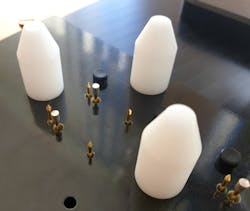Cost-reduction and simplification (.PDF Download)
The need for high-power semiconductors like diodes, MOSFETS, or IGBTs is increasing rapidly. All areas of renewable energy, e-mobility, or industrial electronic drives have a strongly growing need for more powerful components.
Testing these components is a big challenge for test engineers, since currents and voltages have been rising rapidly in the last few years and will continue as such going forward. To cut excess costs in mass volume production, these tests have to be done at different steps in the process, from front-end wafer level, bare-die, to back-end, where the discrete component and final product is tested. On one hand, this is mandatory to ensure consistently high quality and reliability of the devices. On the other hand, it is also important to detect failing parts as soon as possible—avoiding continuous processing of failed parts, and therefore lower production costs. The best cost-saving results can be achieved if you are able to completely cover test specification in every process step. For the most part, this isn’t easy. I’ll explain why—further along in this article—and provide an example that shows how you can work around problems by calculating for testing the RDS(on) static on-resistance parameter of a MOSFET. Most of that can be adapted to the measurement of Vf forward voltage of a diode or VCE,sat saturation voltage of an IGBT.
